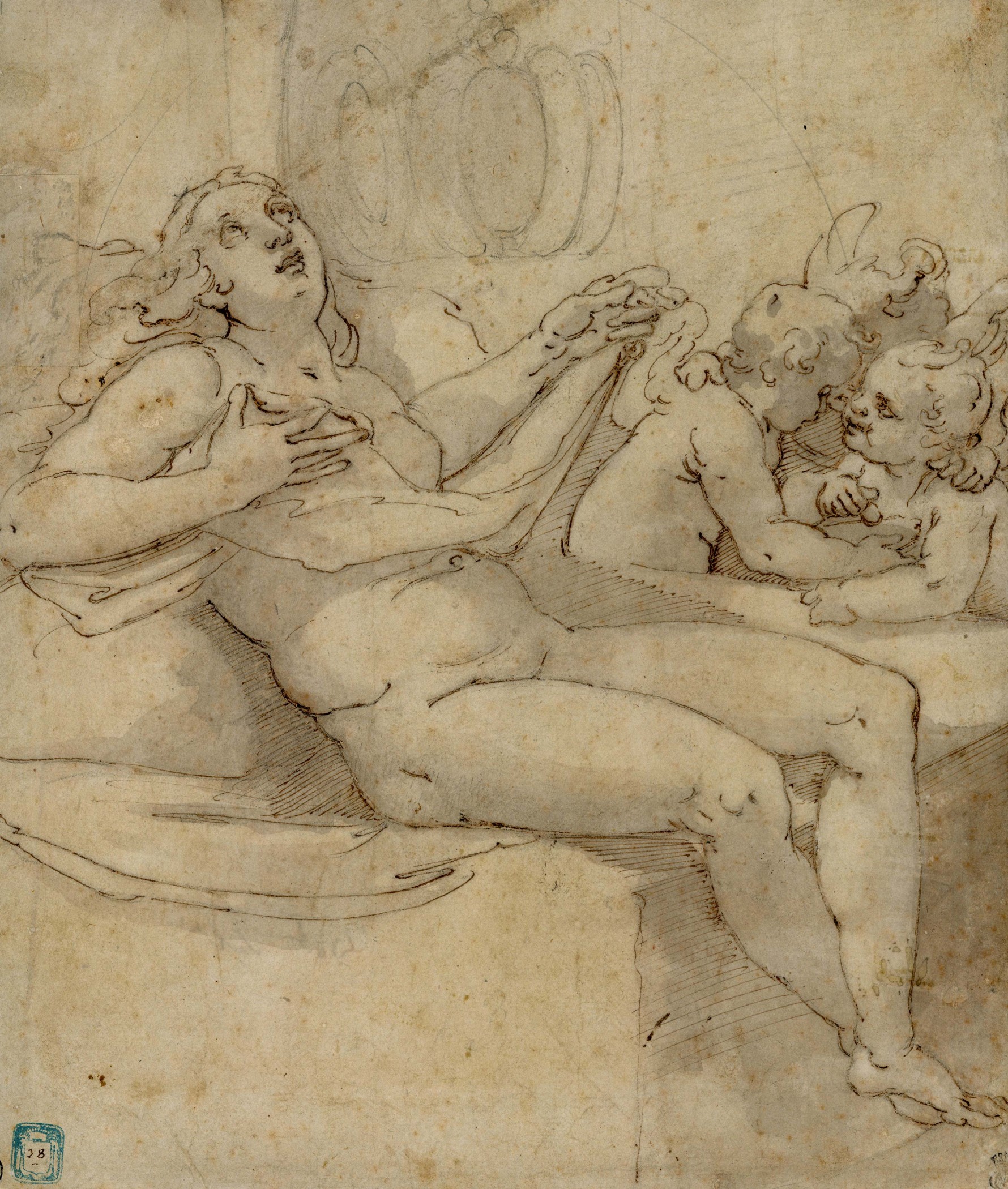Pietro Liberi
(Padua, 1605 (or 1614) - Venice, 1687)
Danae, c. 1675
black pencil, pen, dark ink and watercolour on beige paper
Pietro Liberi
(Padua, 1605 (or 1614) - Venice, 1687)
Danae, c. 1675
black pencil, pen, dark ink and watercolour on beige paper
Re: 0266
Provenance: Marseille, Pascalis (?), Lugt n. 2707
Price: € 3.800,00 - circa US $ 4.142,00
Description:Reclining on a bed and lifting the sheet to reveal her bosom, Danaë is portrayed in a full-figure pose as she allows herself to be seduced by Jupiter in the shape of a cloud. In the middle ground on the right, cupids are seen conversing with one another, seemingly astonished by the scene taking place virtually in their presence.
The drawing, in pencil, pen and watercolour, depicts the famous episode of the amorous tryst between Jupiter and Danaë, a princess of Argos – a story found both in Ovid’s Metamorphoses and in the Bibliotheca by Pseudo-Apollodorus. Acrisius, the girl’s father, had locked her away in a tower to prevent her from conceiving any children. Infatuated with the girl and irate at this interdiction , Jupiter came to her in the shape of a cloud. Entering the tower through a window, he turned into rain which poured onto her naked body. From their union sprung Perseus, the hero who, on reaching maturity, was to slay the Gorgon. The subject, with its considerable erotic charge, was quite naturally to prove immensely popular in Italian art in the Renaissance and in the Baroque era, particularly in Venice where the young aristocratic blades’ mores were considerably more licentious than elsewhere and where sexuality was illustated quite openly in literature and in art. The legend of Danaë was to become one of the most recurrent subjects in “chamber” pictures painted for private secular use in the city, ranging from Titian’s well-known versions of the theme to the 18th century work of Sebastiano Ricci and Giambattista Tiepolo[1].
The drawing under discussion here is also quite clearly the work of an artist from the Veneto, whom we may identify as Pietro Liberi, a master from Padua often cited for his adventurous life. First travelling to Constantinople, he was then nslaved and clapped in irons in Tunis, before becoming a young painter both at the papal court and at the court of Ferdinand II de’ Medici in Florence[2]. His first-hand knowledge of Pietro da Cortona’s work and his lengthy study of the frescoes of Raphael and Michelangelo in Rome meant that by the time he reached Venice in 1643, he was held to be the most authentically Baroque painter in the lagoon city. His Baroque style unquestionably owed a considerable debt to the models of the previous century – and indeed, this was also the case in Rome – but at the same time he was open to the influence of contemporary European painting, as we can see both from his large altarpieces and from his substantial production of “chamber” paintings. His training in Rome and Florence played an important role in shaping his approach to drawing. In that connection his initial ideas for subjects, drawn with the ease and nonchalance of the great masters, are especially worthy of note. Danaë’s pose in this drawing, for example, is found fairly frequently in his graphic output, for example in a drawing of Leda and the Swan in the Galleria Estense in Modena[3] which – like the Rape of Europa in the same museum – is eminently comparable, and this, despite his use of a pen and red pencil as his medium in the Modena drawing. The subjects in question cannot be specifically linked to any of Liberi’s known paintings, which suggests that they were inventions sketched on the spur of the moment for use as a repetoire into which he could freely dip when painting other figures.
Federico Giannini
[1] For Tirian’s various versions of Danaë see Sylvia Ferino Padgen’s recent essay: S. Ferino Padgen, Da Venere a Danae, in Tiziano e l’immagine della donna nel Cinquecento veneziano, ed. S. Ferino Padgen, exhibition catalogue (Milan, Palazzo Reale, 23/2 – 5/6/2022), Milan 2022, pp. 278-285. Ricci’s and Tiepolo’s paintings of the same subject are to be found in the museum in Wiesbaden and at Stockholm University respectively.
[2] Liberi’s extraordinary life story is narrated in a manuscript dated 1664 (thus while the artist was still alive) written by Count Galeazzo Gualdo Priorato of Vicenza: G. Gualdo Priorato, Vita del Cavaliere Pietro Liberi, pittore padovano, ed. Vicenza 1818. See also: C. Accornero, Pietro Liberi cavaliere e fenice dei pittori. Dalle avventure di spada alle lusinghe dell’accademia, Treviso 2013.

